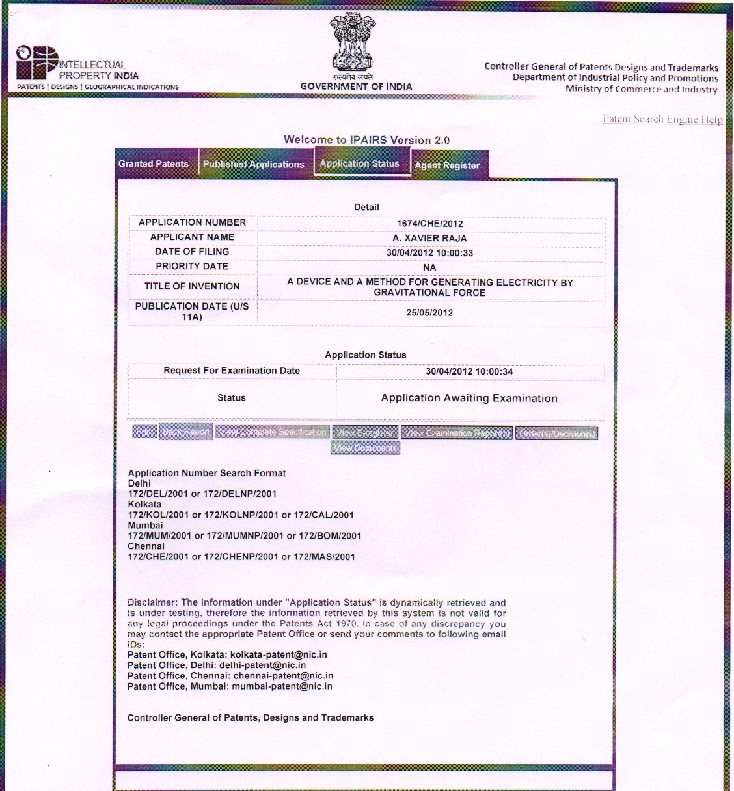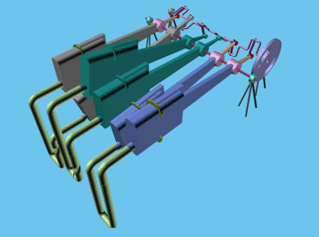


Here two Aluminum Florence flasks are used. One is length shaped Florence flask and another one is oval shaped Florence flask. The oval shaped Florence flask is filled with water. It is closed air tight along with a pipe. A clamp is attached just above where the pipe and the pot shaped Florence flask are in contact. Because of pressure difference the water flows towards A through in the upward direction. Therefore the weight of A increases and it moves downwards due to the gravitational force when it moves downwards the Gear attached to the shaft rotates thereby rotating the armature coil of the dynamo which is connected to the Gear which in turn produces current. Thus the current is produced throughout the day because of the downward and upward molecule of the shaft and gear due to the gravitational force.
Here there are two Aluminum Florence flasks A and C. One is length - wise shaped flask A and another one is oval shaped flask C just like a pot. Half of the pot shaped Florence flask contains water.
The front portion of the length shaped flask D is immersed in water contained in Florence flask C. The Florence flask C is closed air tight along with the tube D. There is a clamp attached just above the part-C where the pot shaped flask C and the pipe D are in contact. Two long shafts are attached on two sides of the clamp. The two shafts are 180 phase difference between them.
Two bearings are attached to the center of the two shafts. They are connected to the steel stand which rest on the ground. So that the pot containing water and Florence flask A and C freely rotate about its axis Two Gear wheels J are connected to the two ends of the shaft.
Other end of the tube D contains a hollow ball shaped cloth vessel. Outer surface of the hollow ball is covered by thick cloth. When the cloth gets wet, temperature inside A is reduced and the pressure inside also gets reduced and becomes a vacuum. In order to fill up the vacuum, water from the Florence flask C flows through D onto A.
When water from D fills A its weight increases and it behaves like a lever moving downwards due to gravitational force. The Gear wheel which is attached to the shaft begins to rotate. Hence the armature coil of the Dynamo which is connected with the Gear wheel also rotates and produces the current. Thus the part A which behaves like a lever when it moves downwards rotates through an angle 135 and it is stopped by a steel stand.
Now air rushes from pot C into flask A which in-turn creates water from A to flow back into pot C. Now the water from the A part flows through D onto the Florence flask C. Therefore the weight of C increases and it moves downwards due to gravitational force and A part move upwards. Hence the shaft and gear rotates the same angle 135 and the armature of the Dynamo which is connected to the Gear wheel also rotates and produces the current in the opposite direction.
This process gets repeated and more amount of current are produced for every downward motion of A and C due to gravitational force. Thus we can obtain current for all the 24 hours of the day because of the availability of gravitational force.
In this invention when we use serial (3to5) units continuous current can be derived. The current can be saved in a battery and can be used continuously. A small scale model is shown here. If we extend it in a large scale we can get enough current for domestic and for the industrial uses. The outer area of Part A can be cooled by few drops of water circulated once in a few hours. This is working in the principle of 100% gravitational force. So no extra energy is needed for operating this unit. It is similar to the lever principle.
Inside Disel Engine Coolned Water







Gravitational force caused by the Earth is available everywhere in the Globe as a free source of energy. This free energy can be utilized for producing electricity and other. Hydrogen has got a property to rise up in the atmosphere (since it is of a lesser density) which is in opposite to the direction of the Gravitational Force. By properly utilising these two opposite forces (i.e. the downward force of the gravity and the upward force of the Hydrogen) in a Crank of an Engine, Electricity can be produced.

In my model, there are two Hydrogen cans. They are connected by a flexible Plastic tube which is in between them. So hydrogen gas can flow alternatively into each can, and can lift them easily.
Two Levers' other ends, whose one ends are connected to each of the Hydrogen cans, are connected with a Crank oppositively at an angle of 180 degrees. This is a set of hydrogen cans. Similarly, there are three sets of hydrogen cans connected by a connecting rode with the Crank. The overall appearance is like a Three Piston Engine. Since the angle between each sets of them is 120 degrees the Hydrogen gas in the cans can produce a high force automatically through the flexible tube.
When this device is made in a big size, we can get the necessary RPM and HP. It can be used as an Engine for small vehicles and the rotation of the Crank Shaft can also be used to produce current by connecting the shaft to the armature of a Generator.

